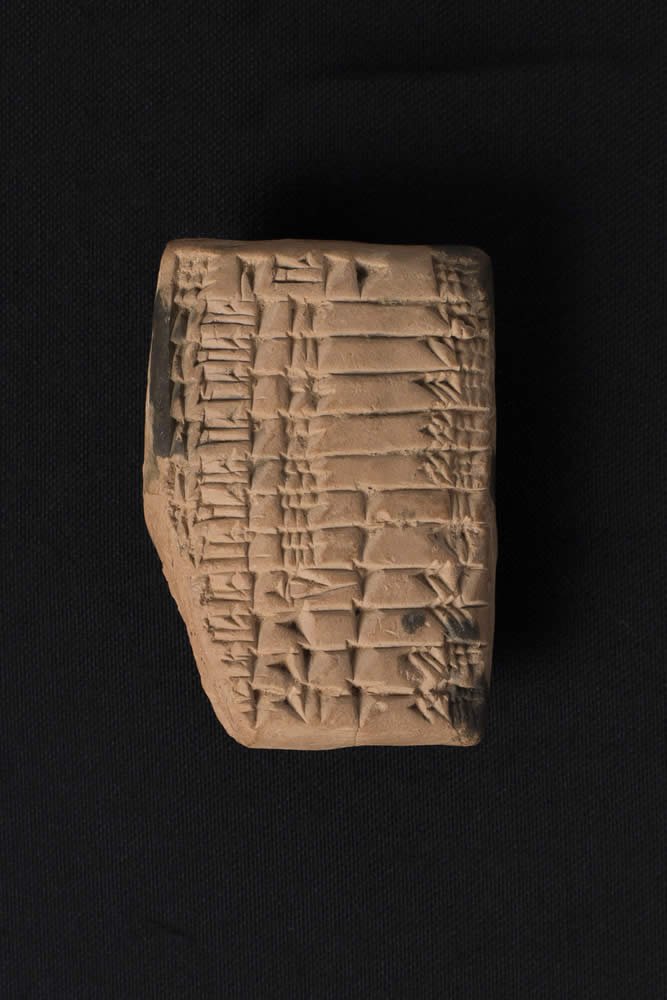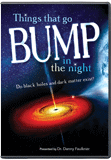
Cosmos Review: “Unafraid of the Dark”
Episode 13 of Cosmos: A SpaceTime Odyssey
Cosmos Articles and Discussion Guides
See Cosmos: A SpaceTime Odyssey for reviews of other episodes and discussion guides for further study.
In the final episode of Cosmos: A SpaceTime Odyssey host Neil deGrasse Tyson moves from the ancient library of Alexandria to modern discoveries concerning dark energy, dark matter, and cosmic rays. Tyson admits that scientists still have much to learn and are even fallible. He illustrates some of that fallibility himself. Tyson closes the series by telling us why we need to know the truth about our origins.
While we agree that it is important to know the truth, Tyson’s trusted source and conclusions differ radically from ours. Tyson depends upon man’s fallible assumptions about a time no man has witnessed, but we as Bible-believing Christians not only trust in the truth of God’s eyewitness account of our origins but also see no conflict between the Bible and science.
Alexandria, the World’s Library
Founded in 283 BC, the library in the Egyptian city of Alexandria housed the ancient world’s greatest collection of written knowledge. There Greek-speaking scholars collected and copied all available scrolls and made them accessible to scholars.
Tyson claims the library was destroyed by a mob that had no appreciation for scholarship. “Knowledge belonged to the elite,” he says, “so in the fourth century AD when the mob came to destroy the library—the genius of classical civilization—there were not enough people to defend it.” Comparing the library’s storehouse of knowledge to that available electronically today he asks, “What will happen the next time the mob comes?” Tyson leaves us to imagine the identity of the modern enemies of knowledge.
History does not, however, record that the ancient world’s collected wisdom was wiped out by a knowledge-fearing mob. Scholars today believe the library suffered a series of mishaps as well as a number of restorations over the centuries until it diminished in importance. The library’s decline was far less dramatic than Tyson reports.1
Answers in Genesis astronomer Dr. Danny Faulkner, who has noted the poor handling of history in Cosmos in other episodes, comments,
I caught the endorsement of a single theory of the demise of the Alexandrian library. There is no agreed upon time or reason for its destruction. To endorse one theory—and that in a very cavalier way—has been the hallmark of handling historical information in this series.
Manuscripts of the Old Testament
Tyson’s history-telling continues to be flawed when he says, “The Old Testament Bible comes down to us mainly from the Greek translations made here [in the library of Alexandria].” He refers to the Septuagint, which was circulating among Greek-speaking people even in the time of Jesus, as suggested by our Lord’s use of some phrases from it. Nonetheless the Old Testament Bible was scrupulously preserved in Hebrew from antiquity by Jewish scribes called the Masoretes. Their remarkable care of the these Scriptures is attested to by the agreement of the Hebrew Scriptures with the Dead Sea Scrolls, manuscripts that predate the previously recognized oldest extant copies of the Old Testament by about 900 years.
The Old Testament has been well preserved throughout history, coming down to us from ancient times in Hebrew. Jerome, who translated the Bible into the Latin Vulgate in the fourth century, was proficient in Greek, but he produced his Old Testament translation from Hebrew texts.2 When translators began producing Bibles in the vernacular of many European people in the 16th and 17th centuries, though they were able to consult the Septuagint, the integrity of the Hebrew Old Testament made good quality Hebrew texts the authoritative source for God’s written Word. The Geneva Bible, completed in 1560, relied entirely on the Hebrew manuscripts for its Old Testament. The King James translators wrote that they consulted “whatever helps were needful” but made their Old Testament translation from the Hebrew texts preserved by the Masoretes. The safe arrival of the Old Testament Bible in the modern world in no way owes itself to the Greek translation made at Alexandria.3
These examples from the Green Collection were on display at the Creation Museum in Petersburg, Kentucky, as part of the exhibit titled “Preserving the Word: Scribal Practice through Time.”
The tablet illustrates the sort of scribal training going on in the time of the Old Testament patriarchs. Writing and arithmetic are not modern inventions! These two Hebrew manuscripts exemplify the enormous care still being taken by scribes in their handling of the smallest details of the Hebrew Old Testament during and after the Middle Ages.

GC.CUN.000249: Scribal multiplication table by nines, Southern Iraq, circa 18th century BC
After completing their training, many scribes went on to work for temples and palaces in an administrative capacity. As a result, it was important for scribes to be accomplished not just in reading and writing, but also in math and accounting. The tablet shown here represents a student’s efforts at writing out a multiplication table by nines. Unfortunately, this scribe made an error and mistakenly answered 9x6 as 49! [Image and caption courtesy of the Museum of the Bible.]

GC.MS.000155: Pocket Bible, Southern France, circa 1230–1240
Mass production of a single-volume, portable “Pocket Bible” was made possible by the rise of professional scribes in the thirteenth century. These manuscripts, often copied near universities, included headings at the top of each page, modern chapter divisions, and supplementary material like the Interpretation of Hebrew Names. The extensive series of theological notes in the margin were likely written by a theology student at one of the universities in southern France, like Toulouse or Montpelier. Compare them to the formal handwriting of the biblical text. [Image and caption courtesy of the Museum of the Bible.]

GC.SCR.00179: Torah Scroll in the German Style, Poland, circa 1780–1810
This large scroll contains the entire text of the Torah, open here to the Song of the Sea, or the song Miriam sings in Exodus 15:1–18. This passage is physically laid out on the parchment quite differently from the rest of the text around it. Jewish sofers [Jewish scribes with the expertise to handle the Scriptures] had to follow strict guidelines for formatting the Song of the Sea, so here the scribe has stretched some of the letters to reach the end of the line. The scribe has also adorned some letters with tagin, or crown-shaped decorations that have particular significance in Cabala, a branch of Jewish mysticism. [Image and caption courtesy of the Museum of the Bible.]
Ever Learning
Dark energy and dark matter are so named because they cannot be directly observed and hence knowledge of them remains, metaphorically, in the dark. Only the effects of dark energy and dark matter are observable. For example, the existence of dark energy is suggested as the invisible cause of the universe’s accelerating rate of expansion. Similarly the existence of dark matter is deduced from the surprisingly fast orbital speed of the outermost stars orbiting galaxies.
The orbital speed of an object—be it moon, planet, or star—is related to the radius of its orbit and the mass that it orbits. The exceptionally fast orbits of stars orbiting galaxies suggest galaxies contain far more mass than the mass of the visible stars in them. In fact, it appears that only about 10 percent of the mass in the universe is actually visible to us. Astronomer Dr. Danny Faulkner says,
What I find sobering and humbling about this is the fact that we know a lot about the universe, but probably 90 percent of the matter in the universe is simply invisible to us. And it’s not like it’s just normal matter that’s hidden. Normal matter ought to be giving off radiation but this is not, so it’s probably a form of matter that we don’t even know about yet. It’s a totally unknown type of matter—totally bizarre, totally different from what we’re used to.
Dark matter, dark energy, and cosmic rays are examples of wonders whose existence came as a surprise to many scientists. Before describing them, Tyson tells a story about a hypothetical planet in a galaxy far, far away where a subgroup of the planet’s intelligent aliens “believe they have it all figured out. Their world is the center of the universe, a universe made for them and that they know everything they need to know about it. Their knowledge is complete,” he says, adding, “How seriously would you take their claim?”
While Tyson never explicitly states the purpose of his illustration about the narrow-minded aliens, he does say that one of the things he loves about science is that “we don’t have to pretend we have all the answers.” Creation scientists likewise do not pretend to have all the answers and love to discover more about the universe God created. Neither Bible-believing scientists nor evolutionary scientists have answers to explain how everything in the universe works. Bible-believing scientists, however, understand that the biblical history of our origins and the global Flood not only place limits on what is possible but also can help predict other unsuspected scientific discoveries. (Read more about this in “Can Bible-Based Predictions Lead to Scientific Discoveries?”)
Cosmic Question
Cosmic rays are showers of subatomic particles moving through space at nearly the speed of light. Some of these showers come from supernovae. Once upon a time—about 2 million years ago, Tyson explains—a nearby supernova gave Earth a radiation bath. This left an unusual isotope of iron as a calling card preserved in the thin layers of manganese nodules on the bottom of the ocean. “How can we possibly know this?” he asks. The cosmic clock for this question is calibrated, Tyson says, using the “known growth rate” of the manganese nodules scattered on the seafloor—“a millimeter in a million years.”
Manganese nodules are accumulations of minerals precipitated from seawater, probably through interaction with bacteria that oxidize manganese dissolved in seawater. Despite Tyson’s emphatic statement—“They grow very slowly. I’m talking a millimeter in a million years.”—scientists report a wide range of nodule growth rates. For instance, in 2006 Shcherbov and Strakhovenko reported that nodules in the alkaline water of an Altai Territory reservoir grow at least 1.7–1.8 millimeters per year.4 They note that manmade objects of known provenance—such as war debris in the Karelian lakes—accumulated five centimeters of this sort of material in just eight to nine years.5 Laboratory-grown micronodules can grow in just a few weeks.6 The rate at which the surrounding ocean sediment accumulates as well as the concentration of dissolved minerals and the pH of the water affect the growth rate, which can be quite rapid.
Despite the enormous variation in manganese nodule growth rates observed by secular scientists, Tyson reports,
Researchers found telltale traces of this iron in a thin layer below the surface of the manganese nodules.7 They used the known rate of growth of the nodules to date that layer to connect it to the fate of a star that perished eons ago. The difference between seeing nothing but a pebble and reading the history of the cosmos inscribed inside it is science. (emphasis ours)
Answers in Genesis geologist Dr. Andrew Snelling, commenting on this bold claim, says,
The nodules are not 2 million years old, but barely 4,300 years old, formed since the Flood.
As for reading the history of the cosmos from what’s inside a pebble, that’s storytelling. Science is about analyzing what’s inside the pebble, it’s chemical and mineralogical composition, which is observable and repeatable in the laboratory.
Reading the cosmos’s history as Tyson does is akin to reading a crystal ball, which for most doesn’t qualify as science, just story-telling based on the myth perpetrated by the deceiver Satan that there is no Creator God.
Why It Matters
In drawing Cosmos: A SpaceTime Odyssey to a close, Neil deGrasse Tyson puts the spotlight on the evolutionary focus of the entire series. Recalling themes like the age of the earth and how life evolves, he asks, “What difference does that make?” His answer is that when he realizes how “big” the universe is he is “uplifted” and wants to know that the feeling he has is justified. He is uplifted by the “legacy of cosmic evolution spanning billions of years.” He says if we come to “know and love nature as it really is then we will surely be remembered by our descendants as good strong links in the chain of life and our children will consider this sacred searching.”
Tyson’s worldview is an example of the humanism described in the first chapter of Romans, for he exalts the created world above the Creator. With the presupposition that the evolutionary worldview is true despite the lack of evidence to support it, he treats man as the momentary pinnacle of evolution and glories in both the significance and insignificance of man’s role in the cosmos. The Creator’s assessment of people with this attitude anytime in history is reflected succinctly in Romans 1:22, “professing themselves to be wise, they became fools.”
God, in the Bible, tells us the truth about ourselves. Though man was the pinnacle of God’s creation (according to Psalm 8:4–9), Adam’s rebellion against God has made all of us vile sinners who can only be restored to God through the mercy available through Jesus Christ. The truth about our origins does matter, for in Genesis we learn that sin, suffering, and death came into the world through human failure. This truth prepares us to understand that God’s grace is the only solution to our deepest problems.
Privileged by Grace
The reboot of Carl Sagan’s Cosmos series closes with Carl Sagan’s condemnation of “our delusion that we have some privileged position in the universe.” The Creator God of the entire universe—based on His grace in sending His Son Jesus Christ to sacrificially suffer and die to atone for the guilt of humanity’s rebellion (John 3:16, Romans 6:23)—has nevertheless demonstrated that the human inhabitants of Earth do have a privileged position in the universe.
We are the rebellious descendants of Adam and Eve, however, and our “privilege” has nothing to do with our own merits, goodness, or intelligence. “For by grace you have been saved through faith, and that not of yourselves
,” the Bible says, “it is the gift of God, not of works, lest anyone should boast
” (Ephesians 2:8–9). God’s grace is an undeserved gift to all who repent and trust the merits of Jesus Christ.
When we look around and see a world drenched in the consequences of man’s sinful nature—and when we honestly look in the mirror and see how corrupt we all are (Romans 3:23)—we might well wonder why God chose to focus His love and attention on the rebellious inhabitants of Earth. God has revealed His glorious power to us in the heavens (Psalm 19:11) and in the intricate designs evident in even the most minute components of nature. And though we do not deserve it, God has revealed His great grace and love to us through Jesus Christ.
For More Information:
- Can Bible-Based Predictions Lead to Scientific Discoveries?
- Cosmos Review: “The Clean Room”
- Cosmos Review: “World Set Free”
- Rare Bible Manuscripts on Display at Creation Museum
- Read all our Cosmos reviews.
- “Preserving the Word”
- How Did We Get the Bible in English?
- The Preservation of the Bible
- Dead Sea Scrolls—Timeless Treasures from Qumran
Footnotes
- The bulk of the classical world’s wisdom was not lost since most was preserved in copies scattered throughout the ancient world. Nevertheless, the mass loss of such a large collected body of literature is tragic, even if its loss was protracted. For a referenced account of its ups and downs, see Annalee Newitz, “The Great Library at Alexandria was destroyed by budget cuts, not fire,” io9.com, 10/8/2013, http://io9.com/the-great-library-at-alexandria-was-destroyed-by-budget-1442659066.
- The King James translators record this fact in their lengthy preface to the King James Version of the Bible. They write, “S. Jerome maketh no mention of the Greek tongue, wherein yet he did excel, because he translated not the Old Testament out of Greek, but out of Hebrew.”
The original text of Septuagint (LXX) translation has not been preserved for us to examine, but the copies of it available to us today suggest care was not taken to preserve the information from the original Hebrew texts accurately. For instance, Dr. Floyd Nolen Jones, author of The Septuagint: A Critical Analysis, gives one of many examples in his book The Chronology of the Old Testament. He writes,
The majority of LXX manuscripts give 167 as the age of Methuselah at the birth of his son, Lamech (the Hebrew reads 187, Gen. 5:25). However, if Methuselah were 167 at the birth of Lamech, Lamech 188 at the birth of Noah, and Noah 600 at the Flood (as recorded in the LXX), Methuselah would have been 955 at the date of the Flood. Since he lived to be 969 (the life span given in both) the LXX becomes entangled in the absurdity of making Methuselah survive the Flood by 14 years!
God’s Word faithfully preserved by the Hebrew Masoretes records in Genesis that Methuselah died before the Flood, and Genesis 7–10 and 1 Peter 3:20 are clear that only Noah, his wife, and his three sons and their wives survived the Flood.
- They write, “The growth rate of nodules with the maximum size of 20–25 mm may be estimated at 1.7–1.8 mm/yr. However, the growth rate may be higher” (B.L. Shcherbov and V.D. Strakhovenko, “Nodules in Sediments of an Artificial Reservoir in the Altai Territory,” Lithology and Mineral Resources 41, no. 1 (2006), doi:10.1134/S0024490206010044, http://link.springer.com/article/10.1134%2FS0024490206010044).
- Ibid.
- Ibid.
- This refers to the isotope iron-60. Iron-60 can be produced by the rapid bombardment of atomic nuclei by neutrons. This “r-process” is thought to occur in supernovae, explains Dr. Danny Faulkner. “Hence,” he says, “the discovery of Fe-60 in manganese nodules suggests recent exposure to products affected from a supernova.” Read more about this “r-process” in Dr. Danny Faulkner, “A Discussion of Stellar Nucleosynthesis,” Answers Research Journal 7, https://beta.answersingenesis.org/astronomy/solar-system/discussion-stellar-nucleosynthesis/.
Recommended Resources

Answers in Genesis is an apologetics ministry, dedicated to helping Christians defend their faith and proclaim the good news of Jesus Christ.
- Customer Service 800.778.3390
- © 2024 Answers in Genesis




